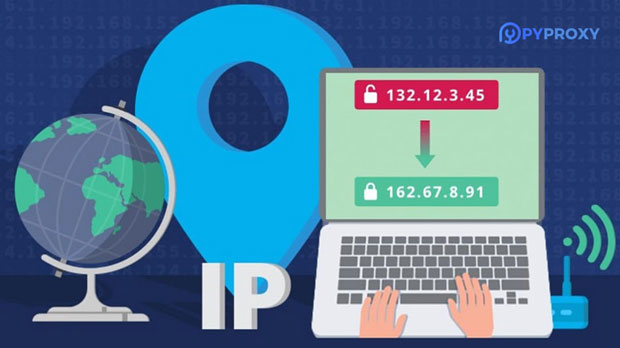In today's fast-paced digital world, frequent dynamic IP switching is becoming increasingly common, especially in fields such as web scraping, automation, and data gathering. This frequent switching creates unique challenges for proxy services that need to ensure reliability, anonymity, and security while overcoming obstacles like IP bans or geographical restrictions. Two popular proxy solutions in this regard are PYPROXY and Proxyscrape. This article will provide an in-depth comparison of the adaptability of these services in handling frequent dynamic IP switching, with a focus on their unique features, strengths, and potential limitations. Understanding their performance can help businesses and individuals make more informed decisions when choosing the right tool for their needs. Introduction to Dynamic IP Switching and Proxy RequirementsDynamic IP switching refers to the process of frequently changing the IP address used by a device or server. This is common in many situations such as bypassing geo-blocks, avoiding rate limits, or conducting anonymous browsing. In the context of proxy services, dynamic IP switching requires advanced technology that ensures the stability and effectiveness of these IP changes, making sure users can continue their tasks without interruption. To effectively manage such scenarios, proxy solutions must be able to provide a continuous supply of new, anonymous IP addresses while maintaining their speed, security, and geographical coverage. PyProxy and Proxyscrape offer different approaches to this challenge, each with its unique set of features and capabilities.What is PyProxy?PyProxy is a powerful Python-based proxy tool designed for developers who need robust proxy rotation capabilities. It enables users to automatically switch between multiple proxy servers at set intervals, reducing the likelihood of encountering IP bans or rate-limiting issues during data scraping or other automated tasks.One of the key features of PyProxy is its ability to support various proxy protocols such as HTTP, HTTPS, and SOCKS5. Additionally, it allows users to configure custom proxy lists and manage IP rotation seamlessly, making it a flexible option for those who need complete control over their proxy rotation. PyProxy also integrates well with various Python libraries and frameworks, making it a popular choice for those already familiar with the Python programming language.However, PyProxy does come with some limitations. It requires manual configuration and a certain level of technical knowledge to set up. This may not be ideal for users who are not comfortable working with Python or prefer a more user-friendly interface. Additionally, while PyProxy offers excellent flexibility, its performance heavily relies on the quality and size of the proxy pool users provide. If the proxy pool is limited or of poor quality, PyProxy may struggle to provide the same level of effectiveness in dynamic IP switching.What is Proxyscrape?Proxyscrape, on the other hand, is a service that focuses on providing free and paid proxies with an easy-to-use interface. It is particularly known for its ability to provide fresh proxies in real-time, making it an excellent choice for users who need quick access to large pools of dynamic IPs. Proxyscrape regularly updates its proxy lists, ensuring that users have access to high-quality, working proxies at all times.Proxyscrape offers a variety of proxy types, including anonymous, elite, and transparent proxies, and also provides both rotating and static proxy options. Users can choose proxies based on their specific needs, whether for web scraping, accessing geo-restricted content, or maintaining anonymity while browsing. Furthermore, Proxyscrape offers integration with various third-party tools and APIs, making it easy to integrate into existing systems and workflows.One of the standout features of Proxyscrape is its user-friendly interface and ease of use. Even users with limited technical knowledge can quickly start using the service, making it an attractive option for non-technical users who need dynamic IP switching capabilities. However, the free version of Proxyscrape has limitations in terms of speed and the number of available proxies, so users who require higher performance or access to a larger pool of proxies may need to upgrade to the paid version.Comparing the Adaptability of PyProxy and ProxyscrapeWhen comparing PyProxy and Proxyscrape in the context of frequent dynamic IP switching, both services offer distinct advantages and drawbacks depending on the user's needs.Performance and Reliability PyProxy offers strong performance in terms of control and customization. It gives users the ability to manage their proxy pools and configure rotation rules, ensuring a more tailored approach to dynamic IP switching. However, its reliance on a manually configured proxy pool means that its performance can be highly variable depending on the quality of the proxies being used. In contrast, Proxyscrape excels in providing a large number of pre-configured, regularly updated proxies, which can be beneficial for users who need fresh IPs without the hassle of maintaining their own proxy pool.Ease of Use Proxyscrape is more user-friendly, with an intuitive interface and easy setup process. This makes it a better choice for users who do not have extensive technical knowledge or those who need a quick and easy solution for dynamic IP switching. PyProxy, while powerful and customizable, requires users to have some familiarity with programming, specifically Python, in order to set it up and use it effectively.Cost and Accessibility Proxyscrape offers both free and paid versions, making it accessible to a wide range of users. The free version, however, may not provide the level of performance or proxy variety required for more intensive tasks. PyProxy, on the other hand, is a free tool, but users must source their own proxies or subscribe to a third-party proxy service, which could add to the overall cost.Customization and Control PyProxy offers greater customization and control, allowing users to fine-tune their proxy rotation settings and proxy pool configuration. This is ideal for developers and businesses that require a high degree of control over their proxy setup. Proxyscrape, while offering good performance out-of-the-box, is less customizable in comparison, making it more suitable for users who need a plug-and-play solution without needing to delve into technical details.Conclusion: Choosing the Right Proxy Service for Dynamic IP SwitchingBoth PyProxy and Proxyscrape offer solutions for dynamic IP switching, but the best choice depends on the specific needs of the user. PyProxy is ideal for developers and users who require a high degree of control and customization, as it offers flexible configuration options and integrates seamlessly with Python-based workflows. However, its reliance on a self-managed proxy pool can make it challenging for less technical users.On the other hand, Proxyscrape is more user-friendly and accessible, offering a range of pre-configured proxies with minimal setup. It is a good option for those who need a straightforward solution for dynamic IP switching without needing to invest time in managing proxy pools. However, users may need to upgrade to the paid version for optimal performance and a larger proxy pool.In conclusion, users should assess their technical expertise, budget, and specific requirements before deciding between PyProxy and Proxyscrape. Both services have their strengths and can provide reliable solutions for managing frequent dynamic IP switching in different scenarios.
Sep 12, 2025


































































